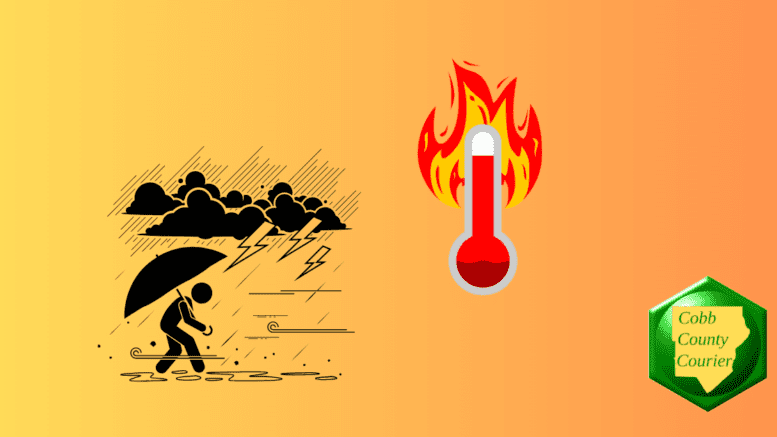The National Weather Service has issued a hazardous weather outlook for north and central Georgia, forecasting potentially dangerous thunderstorms and extreme heat index values that could result in heat-related illnesses.
The hazardous weather outlook is for Tuesday, July 22. Visit the complete outlook on the National Weather Service site by following this link.
Bonus for the more weather-curious among you … To read an article about interpreting a weather news report with some of the typical terminology defined, follow this link.
What is in the National Weather Service Statement?
The statement gives the following details:
This Hazardous Weather Outlook is for north and central Georgia.
.DAY ONE…Today and Tonight…
Scattered to numerous thunderstorms are expected this afternoon
and evening across parts of north and central Georgia. A few
storms may produce damaging wind gusts, heavy rainfall, and
frequent lightning.Heat index values ranging from 100 to 109 degrees are expected
across parts of central Georgia. A Heat Advisory is in effect for
areas where widespread values at or above 105 degrees are
expected. Precautions should be taken to avoid heat-related
illnesses..DAYS TWO THROUGH SEVEN…Wednesday through Monday…
Scattered afternoon and evening thunderstorms will persist
through Monday. The potential for widespread severe weather is low
each day.Heat index values are expected to reach 100 to 105 degrees,
possibly higher, again on Saturday, Sunday, and Monday.
The following counties are included in the hazardous weather outlook:
Baldwin, Banks, Barrow, Bartow, Bibb, Bleckley, Butts, Carroll, Catoosa, Chattahoochee, Chattooga, Cherokee, Clarke, Clayton, Cobb, Coweta, Crawford, Crisp, Dade, Dawson, DeKalb, Dodge, Dooly, Douglas, Emanuel, Fannin, Fayette, Floyd, Forsyth, Gilmer, Glascock, Gordon, Greene, Gwinnett, Hall, Hancock, Haralson, Harris, Heard, Henry, Houston, Jackson, Jasper, Jefferson, Johnson, Jones, Lamar, Laurens, Lumpkin, Macon, Madison, Marion, Meriwether, Monroe, Montgomery, Morgan, Murray, Muscogee, Newton, North Fulton, Oconee, Oglethorpe, Paulding, Peach, Pickens, Pike, Polk, Pulaski, Putnam, Rockdale, Schley, South Fulton, Spalding, Stewart, Sumter, Talbot, Taliaferro, Taylor, Telfair, Toombs, Towns, Treutlen, Troup, Twiggs, Union, Upson, Walker, Walton, Warren, Washington, Webster, Wheeler, White, Whitfield, Wilcox, Wilkes, Wilkinson
What is the heat index?
The NWS defines the heat index as follows on its website:
The heat index, also known as the apparent temperature, is what the temperature feels like to the human body when relative humidity is combined with the air temperature. This has important considerations for the human body’s comfort. When the body gets too hot, it begins to perspire or sweat to cool itself off.
Chart from NOAA showing the relationship between relative humidity and temperature in the heat index
What is meant by “isolated” and “scattered”?
The NWS defines “isolated” as follows:
A National Weather Service convective precipitation descriptor for a 10 percent chance of measurable precipitation (0.01 inch). Isolated is used interchangeably with few.
“Scattered” has the following definition:
When used to describe precipitation (for example: “scattered showers”) – Area coverage of convective weather affecting 30 percent to 50 percent of a forecast zone(s).
Isolated thunderstorms and scattered thunderstorms are two terms used to describe different distributions of thunderstorm activity within a particular area. The main difference lies in the extent of coverage and how the thunderstorms are spatially distributed:
- Isolated Thunderstorms:
Isolated thunderstorms are relatively rare occurrences that happen sporadically and are generally confined to a limited area.
These thunderstorms are often characterized by being few and far between, with significant gaps between individual storm cells.
Typically, isolated thunderstorms cover less than 20% of the forecast area.
Despite their isolated nature, these storms can still be intense and may produce heavy rain, lightning, gusty winds, and possibly hail. - Scattered Thunderstorms:
Scattered thunderstorms are more widespread than isolated thunderstorms and cover a larger portion of the forecast area.
In a scattered thunderstorm scenario, numerous individual thunderstorms develop, but they are not continuous or widespread enough to be classified as a “line” or “cluster” of storms.
Scattered thunderstorms generally cover between 30% to 50% of the forecast area.
Although scattered thunderstorms are more widespread, they still leave considerable gaps between storm cells, and not everyone within the forecast area will necessarily experience a thunderstorm.
In summary, isolated thunderstorms are fewer in number and more localized, covering a smaller area with significant gaps between storms, while scattered thunderstorms are more widespread, covering a larger area with numerous individual storms occurring somewhat randomly across the forecast area.
About the National Weather Service
The National Weather Service (NWS) is a part of the National Oceanic and Atmospheric Administration (NOAA).
The NWS describes its role as follows:
“The National Weather Service (NWS) provides weather, water, and climate forecasts and warnings for the United States, its territories, adjacent waters and ocean areas, for the protection of life and property and the enhancement of the national economy.
“These services include Forecasts and Observations, Warnings, Impact-based Decision Support Services, and Education in an effort to build a Weather-Ready Nation. The ultimate goal is to have a society that is prepared for and responds to weather, water and climate events.”
